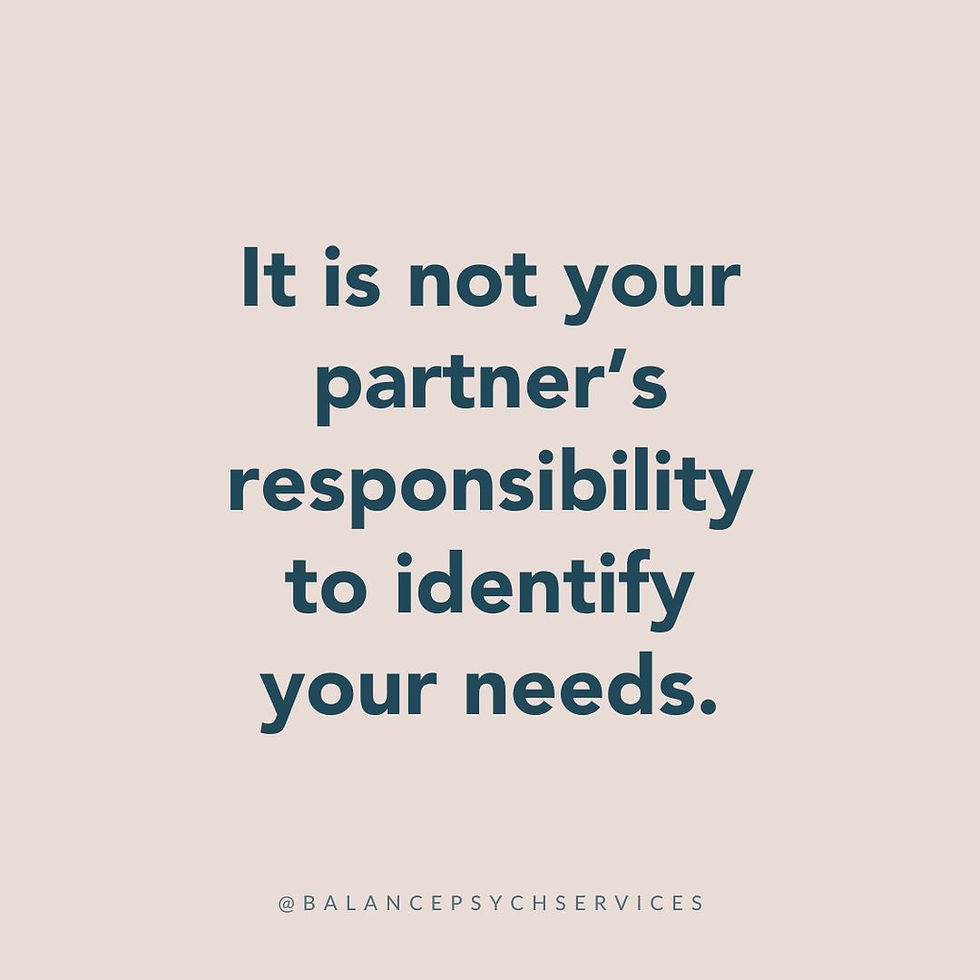Common Communication Barriers for Couples
- Balance Psychological Services
- May 3, 2024
- 6 min read
Updated: Nov 22, 2024
Most couples start their therapy journey with the goal of improving communication and enhancing intimacy. They often say their biggest concern is that they keep having the same arguments over and over again.
Sound familiar?
Many couples find themselves in this situation; trying to resolve conflict just to find themselves right back in it. Most often, they resort to sweeping things under the rug just to keep the peace. Unfortunately, no resolve ever comes from sweeping things under the rug, resentments build, and they end up right back where they started; trying to work through a conflict while creating more problems.
As a therapist, I’ve come to observe that many couples struggle with similar communication barriers. Identifying these barriers is often the first step to resolving the initial conflict cycle, and preventing further ones from happening. Some of the most common barriers that I see are: unrealistic and under-expressed expectations, a lack of validation for your partner’s emotional experience, and criticism, defensiveness, and stonewalling.
Common Communication Barrier No. 1: Unrealistic Expectations
We often expect a lot from our partners, and of course we would. These are the people that we share our lives with, the people that know us best. Because of this, there is often an expectation that our partner would know us well enough to know what we need. But is that even realistic to expect from them?
Expecting your partner to “just know” only creates more conflict and the belief that they don’t care about you. We each have a personal responsibility to identify our own needs and communicate them to others. People are not mind readers.

Our needs come from our feelings and sensations; only I can know what my feelings and sensations are. When we expect our partner to know what our needs are, we set them up for failure and keep them stuck in a place of helplessness trying to meet our needs, but always missing the mark. This leads to resentment in both partners and often causes your partner to stop trying to meet your needs at all because they feel like they will fail anyway, “So why even try?”
It is not your partner’s responsibility to identify your needs. Set your partner up for success by identifying your own needs and communicating them to them.
Common Communication Barrier No. 2: Under-Expressed Expectations
Under-expressed expectations can also create a lot of conflict. The assumption again is that "my partner should just know". The problem with this assumption is that we forget to consider that each person has their own needs and their own expectations.
We often see conflict when each person’s expectations do not match. The best example of this is when each partner has different expectations about what their evening, after work, will look like. This is often the time that most of us depend on to recharge our batteries.
If I expect to go home and relax after work, but my partner has other plans for me, I’m likely to resist or communicate my displeasure with those plans. But, if I’m aware of my partner’s expectations beforehand, they don’t surprise me when I walk through the door. I’m more likely to be willing to support my partner in meeting their needs because I know that I will still be able to meet my own needs, just at a different time.
Common Communication Barrier No. 3: Unwilling to Validate One Another
One of the biggest barriers for effective communication happens when both people get stuck in their own emotional experience and struggle, or are unwilling, to validate their partner’s. Each person becomes so hyper-focused on how they are feeling and, over time, if their needs continue to go unmet, they grow more and more resentful and become unwilling to step into their partner’s shoes to attempt to understand how they might be feeling and why.
Something interesting happens when we are able to do this, though. When I empathize with another person, when I imagine what it must feel like to walk in their shoes, my negative emotions towards them tend to lessen.
Think back to a time where your feelings were validated. How did that make you feel? How did it make you feel about the person that validated your feelings? My guess is probably pretty positive!
Our own resistance to empathy actually prevents us from being seen and having our own needs met. What do you think would happen if you challenged yourself, even though it’s probably the last thing you want to do, to empathize with your partner? Likely, your partner would reflect the same empathy. It takes one person to break that initial invalidation cycle.
Common Communication Barrier No. 4: Criticism, Defensiveness, and Stonewalling
The next three communication barriers often influence one another. When one person leads with criticism, focusing on and highlighting what they believe their partner is not providing them, their partner’s defences go up. In that moment, their partner’s stress response becomes activated, interpreting their partner’s criticism as a threat, preventing them from hearing their partner’s concerns and attempting to understand their feelings and needs.

Criticism is typically met with defensiveness. This is where couples often find themselves going back and forth with their criticisms of one another. Frustrations build and resolve never happens. In both criticism and defensiveness, neither partner is taking responsibility for the role they have played in the situation or conflict at hand. Accountability is a form of validation that creates a softening, an opportunity for defences to come down, and both partners to be heard and supported.
Stonewalling is another frequent response to criticism. "Stonewalling" is when a person appears to check out completely from a conversation; sending the message to their partner that what they have to say is not important and they do not care.
John and Julie Gottman, psychologists and creators of the Gottman Method for Couples Counselling, discovered an interesting piece of information about stonewalling when they were conducting quantitative research in their “love lab” (Gottman, J.M., & Gottman, J. S., 2018). Part of their research involved putting heart rate monitors on each partner while they attempted to resolve a conflict. What they discovered in partners who stonewalled was a significant increase in heart rate, over 100bpm.
What does this mean? Well, it means that stonewalling is actually a reflection of becoming so overwhelmed that the neurological stress response becomes activated. When this happens, a person is no longer able to take in information, process it, and proceed rationally. Instead, their system becomes so overwhelmed that they dissociate, they check out. Men are statistically more prone to stonewall. Theories suggest that men struggle most with feelings of helplessness; recognizing there is a problem, but not knowing how or being able to fix it (Gottman, J.M., & Gottman, J.S., 2018).
It's important to be mindful of how we are communicating. Criticism is often perceived as an aggressive form of communication that ultimately prevents your partner from hearing your message and changing their behaviour. Assertive communication requires communicating how you feel about a situation and what you need from your partner. Communicating feelings and needs simplifies the conversation and moves your partner out of a state of helplessness by giving them something specific to do about “the problem.”
Communication can be challenging. There are many things that can serve as barriers to effective communication, however, awareness of communication roadblocks can be a helpful first step in breaking conflict cycles and creating space for each partner to feel validated and supported.
--
References
Gottman, J. M., & Gottman, J. S. (2018). The science of couples and family therapy: Behind the scenes at the" Love Lab". WW Norton & Company.
About Balance Psychological Services
Balance Psychological Services is a psychological private practice aimed toward healing, growth, and balance. Our mission is to ensure that every person who walks through our doors feels seen and accepted for exactly who they are, no matter the circumstances they are facing. With offices conveniently located in Stony Plain, Edmonton, and Beaumont, we are here and ready to help you find your balance.
Disclaimer
Information provided through Balance Psychological Services' blog posts is meant for educational purposes only. This is NOT medical or mental health advice. If you are seeking mental health advice, please contact us directly at (587) 985-3132.